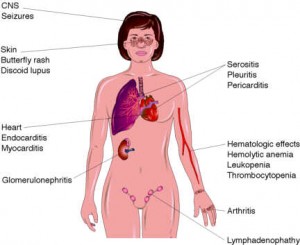Kristen Johnson Battling Rare Form of Lupus
Emmy Awarding winning Third Rock from the Sun actress Kristen Johnston has had her share of health issues. In 2006, she underwent surgery after a burst ulcer spilled her stomach contents into her abdomen. The two month hospitalization was a wake-up call. She realized that she had done this to herself through years of alcohol abuse and an addiction to the prescription pain killer Viodin (originally prescribed for migraines). She became sober and got back to work, most recently starring on the TVLand show, The Exes.
But last fall, Johnston noticed that she was having increasing fatigue and difficulty walking. As she told People magazine:
“I started to have trouble walking up one flight of stairs into my brownstone… When I finally went to the doctor, they told me my white blood count was incredibly low. It was basically the white blood cell count of a dead person.”
Things got progressively worse, with Johnston in a wheelchair and a neck brace, as she “couldn’t even hold her head up.” Over the course of the next 4 months Johnston saw 17 doctors and spent “two-fun filled weeks in November partying at The Mayo Clinic” before she was finally diagnosed. At the suggestion of her producer, Mindy Schultheis, Johnston saw a rheumatologist- Dr. Daniel J. Wallace, author of the book, The Lupus Book: A Guide for Patients and Their Families![]() . After reviewing her medical records, he told her that she had lupus myelitis, a rare presentation of systemic lupus erythematosis.
. After reviewing her medical records, he told her that she had lupus myelitis, a rare presentation of systemic lupus erythematosis.
After 6 months of treatment, Johnston is doing very well and is back to work. According to Dr. Wallace: ” She’s in remission, but if she’d waited a few weeks longer, she could have ended up quadriplegic.”
What is systemic lupus erythematosis (lupus)?
SLE is an autoimmune disease in which the body attacks itself when the immune system fails to recognize the difference between the body’s own cells and tissues and”foreign” substances such as the bacteria and viruses that our immune systems normally protect us against. Anyone can get Lupus, but it is most common among girls and women. More than 90% of people with lupus are female.
What are the symptoms?
Lupus is often difficult to diagnose. It’s often mistaken for other diseases and has been called the “great imitator.” The signs of lupus differ from person to person. Some people have just a few signs; others have more.
- Red rash or color change on the face, often in the shape of a butterfly across the nose and cheeks
- Painful or swollen joints
- Unexplained fever
- Chest pain with deep breathing
- Swollen glands
- Extreme fatigue (feeling tired all the time)
- Unusual hair loss (mainly on the scalp)
- Pale or purple fingers or toes from cold or stress
- Sensitivity to the sun
- Low blood count
- Depression, trouble thinking, and/or memory problems
What is lupus myelitis?
Lupus myelitis is a form of transverse myelitis- a neurological disorder caused by inflammation of the spinal cord.
The term myelitis refers to inflammation of the spinal cord; transverse simply describes the position of the inflammation, that is, across the width of the spinal cord. Attacks of inflammation can damage or destroy myelin, the fatty insulating substance that covers nerve cell fibers. This damage causes nervous system scars that interrupt communications between the nerves in the spinal cord and the rest of the body.
Symptoms of transverse myelitis include a loss of spinal cord function over several hours to several weeks. What usually begins as a sudden onset of lower back pain, muscle weakness, or abnormal sensations in the toes and feet can rapidly progress to more severe symptoms, including paralysis, urinary retention, and loss of bowel control.
What causes transverse myelitis?
Researchers are uncertain of the exact causes of transverse myelitis. The inflammation that causes such extensive damage to nerve fibers of the spinal cord may result from viral infections or abnormal immune reactions (such as that of an autoimmune disease like lupus).
How is transverse myelitis treated?
As with many disorders of the spinal cord, no effective cure currently exists for people with transverse myelitis. Treatments are designed to reduce spinal cord inflammation and manage and alleviate symptoms.. Physicians often prescribe anti-inflammatory corticosteroid therapy soon after the diagnosis is made in order to decrease inflammation and hopefully improve the chances and speed of neurological recovery.
Recovery from transverse myelitis usually begins within 2 to 12 weeks of the onset of symptoms and may continue for up to 2 years (and in some cases longer). However, if there is no improvement within the first 3 to 6 months, complete recovery is unlikely (although incomplete recovery can still occur, which underlines the significant need for aggressive physical therapy and rehabilitation).
Source: National Institute of Neurological Disorders and Stroke




























0 comments